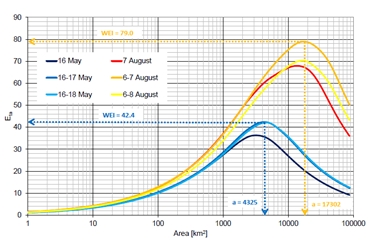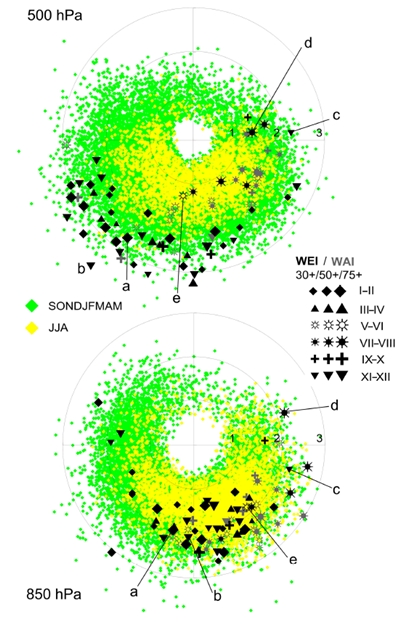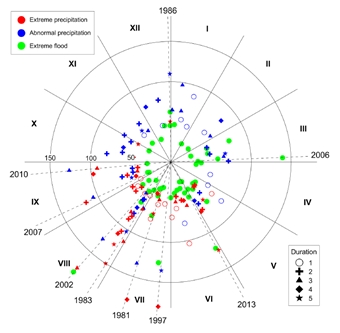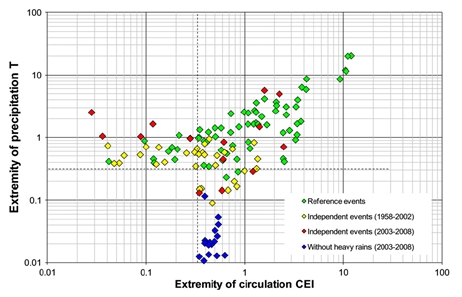Catastrophic floods in July 1997 and in August 2002 enhanced our interest in heavy precipitation and other meteorological and hydrological extremes. We focus on methods of evaluating the extremity of weather events. Within the GAP209/11/1990 project, we have developed the weather extremity index (WEI) which combines several aspects of extreme events, namely the return periods of the given meteorological element, the size of the affected area and the duration of the event. This allows us to describe the time distribution of weather extremes, especially in terms of their seasonality. A similar weather abnormality index (WAI) is used to assess how extraordinary the event was with respect to the given part of year (Müller a Kašpar, 2014). Our Weather Extremity Calculator allows you to compare the extremity of heavy precipitation events with each other.

Determination of the value of the WEI for heavy precipitation events in May and August 2010; the WEI values are obtained by spatial and temporal optimization of the considered area and time window, respectively. Source: Müller and Kašpar, 2014

Relationship between the magnitude of the horizontal temperature gradient and windstorms in Czechia within individual calendar months. Source: Kašpar et al. (2017).
The objectively evaluated weather extremes are further studied from various perspectives. We deal mainly with their meteorological causes, using the method of evaluating anomalies in the fields of appropriate dynamic or thermodynamic variables (Kašpar a Müller, 2014). Within the project GA17-23773S, we analyzed the relationship between the extremity of heavy precipitation, their causal conditions and predictability, using a NWP (numerical weather prediction) model. We also pay attention to the influence of meteorological conditions on the occurrence of floods, which is presented in our Atlas of Floods in the Czech Republic. Within the project GA19-05011S in cooperation with the Faculty of Science of Charles University, we focus on the issue of precipitation extremes in mountain areas. We also deal with the simultaneous occurrence of several types of extremes in the so-called compound weather events, on which the project LTC19043 is focused. A comprehensive analysis of weather extremes in Czechia is the goal of our involvement in the recently launched project ME08011 "PERUN".
The above mentioned analytical approaches were applied to weather extremes, especially to heavy precipitation events, at various spatial scales: within the Czech Republic (Müller et al., 2015), in the Vosges Mountains (Minářová et al., 2017a) and the Ore Mountains (Minářová et al., 2017b; Minářová et al., 2018) and within the whole of central Europe (Gvoždíková et al., 2019). For the territory of the Czech Republic and central Europe, we also evaluated the extremity of floods (Müller et al., 2015; Gvoždíková a Müller, 2017) and the relationship of extreme events to moisture flow anomalies (Gvoždíková a Müller, 2021). In addition to heavy precipitation, we similarly dealt with cases of heat (Valeriánová et al., 2017) and windstorms in the Czech Republic (Kašpar et al., 2017).
- LTC19043: Extremeness and causes of compound weather events in Central Europe, 2019-2022.
- GA19-05011S: Extremeness and causes of compound weather events in Central Europe, 2019-2021.
- GA17-23773S: Extremeness and predictability of precipitation events depending on their properties and atmospheric conditions, 2017-2019.
- GAP209/11/1990: Extreme weather events in the Czech Republic and their relationship to meso-alpha meteorological patterns, 2011-2014.
- Gvoždíková, B., Müller, M., 2021: Moisture fluxes conducive to central European extreme precipitation events. Atmos. Res., 248, 105182.
- Gvoždíková, B., Müller, M., Kašpar, M., 2019: Spatial patterns and time distribution of central European extreme precipitation events between 1961 and 2013. Int. J. Climatol., 39, 3282–3297.
- Minářová, J., Müller, M., Clappier, A., Kašpar, M., 2018: Comparison of extreme precipitation characteristics between the Ore Mountains and the Vosges Mountains (Europe). Theor. Appl. Climatol., 133, 1249–1268.
- Gvoždíková, B., Müller, M., 2017: Evaluation of extensive floods in western/central Europe. Hydrol. Earth Syst. Sci., 21, 3715–3725.
- Kašpar, M., Müller, M., Crhová, L., Holtanová, E., Polášek, J. F., Pop, L., Valeriánová, A., 2017: Relationship between Czech windstorms and air temperature. Int. J. Climatol., 37, 11–24.
- Minářová, J., Clappier, A., Müller, M., Kašpar, M., 2017a: Characteristics of Extreme Precipitation in the Vosges Mountains region (North-Eastern France). Int. J. Climatol., 37, 4529–4542.
- Minářová, J., Müller, M., Clappier, A., Hänsel, S., Hoy, A., Matschullat, J., Kašpar, M., 2017b: Duration, rarity, affected area, and weather types associated with extreme precipitation in the Ore Mountains (Erzgebirge) region, Central Europe. Int. J. Climatol., 37, 4463–4477.
- Valeriánová, A., Crhová, L., Holtanová, E., Kašpar, M., Müller, M., Pecho, J., 2017: High temperature extremes in the Czech Republic 1961–2010 and their synoptic variants. Theor. Appl. Climatol., 127, 17–29.
- Müller, M., Kašpar, M., Valeriánová, A., Crhová, L., Holtanová, E., Gvoždíková, B., 2015: Novel indices for the comparison of precipitation extremes and floods: an example from the Czech territory. Hydrol. Earth Syst. Sci., 19, 4641–4652.
- Kašpar, M., Müller, M., 2014: Combinations of large-scale circulation anomalies conducive to precipitation extremes in the Czech Republic. Atmos. Res., 138, 205-212.
- Müller, M., Kašpar, M., 2014: Event-adjusted evaluation of weather and climate extremes. Nat. Hazards Earth Syst. Sci., 14, 473-483.


